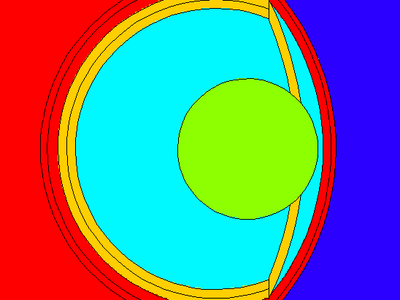
Marine environment
Our marine environment is impacted in many ways by human activities. One of our core tasks is to assess the effects of environmental pollution on fish as a compartment of the marine environment and as an important natural resource. To this end, we investigate which potential pollutants are taken up by fish in which concentrations, how these substances accumulate in the fish, how they affect the fish and which degradation products are formed in the organism, always with a view to potential hazards for consumers. In addition to various inorganic and organic pollutants, the risk assessment of dumped munitions is one of our main research areas.
Ongoing projects
Publications
- 0
Kammann UKR, Scharsack JP (2025) Kontamination durch versenkte Munition: TNT-Metaboliten in Fischen aus Nord- und Ostsee. Mitt Umweltchem Ökotox 31(1):8-11
- 1
Kammann UKR (2025) PAH-Metaboliten in Fischen aus der Nord- und Ostsee (2023) [Datenpublikation] [online]. 1 XLSX-Datei. Göttingen: OpenAgrar, zu finden in <https://www.openagrar.de/receive/openagrar_mods_00104609> [zitiert am 25.02.2025], DOI:10.3220/DATA20250127095929-0
- 2
Kammann UKR (2025) Per- und Polyfluoralkylchemikalien (PFAS) in Fischen aus der Nord- und Ostsee (2023) [Datenpublikation] [online]. 1 XLSX-Datei. Göttingen: OpenAgrar, zu finden in <https://www.openagrar.de/receive/openagrar_mods_00104610> [zitiert am 25.02.2025], DOI:10.3220/DATA20250127102327-0
- 3
Kammann UKR, Schmidt N, Lemaitre A (2025) PFAS FISCH - per- and polyfluoroalkyl substances (PFAS) in fish from German coastal areas. Bremerhaven: Thünen Institute of Fisheries Ecology, 2 p, Project Brief Thünen Inst 2025/08a, DOI:10.3220/PB1738919100000
- 4
Kammann UKR, Schmidt N, Lemaitre A (2025) PFAS FISCH - Per- und Polyfluoralkylchemikalien (PFAS) in Fischen aus deutschen Küstengebieten. Bremerhaven: Thünen-Institut für Fischereiökologie, 2 p, Project Brief Thünen Inst 2025/08, 10.3220/PB1738919029000
- 5
Kammann UKR, Töpker V, Scharsack JP (2025) Tracking explosive contaminants from dumped munition in the western Baltic Sea via urine and bile analysis of three flatfish species. Environ Sci Europe 37:32, DOI:10.1186/s12302-025-01074-0
- 6
Kammann UKR, Töpker V, Scharsack JP (2025) Tracking explosive contaminants from dumped munition in the Western Baltic Sea via urine and bile analysis of three flatfish species [Datenpublikation] [online]. 1 XLSX file. Göttingen: OpenAgrar, zu finden in <https://www.openagrar.de/receive/openagrar_mods_00100741> [zitiert am 06.11.2024], DOI:10.3220/DATA20241022124456-0
- 7
Axen C, Cooper A, Paley R, Bao M, Bignell J, Carnegie R, Cheslett D, Cipriani P, Declercq A, Eriksson-Kallio AM, Gagné N, Garseth A-H, Giulietti L, Grade A, Haenen O, Kristmundsson Á, Levsen A, Madsen L, Mortensen S, Scharsack JP, et al (2025) Working Group on Pathology and Diseases of Marine Organisms (WGPDMO; outputs from 2024 meeting). Copenhagen: ICES, 27 p, ICES Sci Rep 7(17), DOI:10.17895/ices.pub.28343924
- 8
Pham MK, Aust M-O, Bartocci J, Blinova O, Carvalho FP, Chamizo E, Cook M, Degering D, Fujak M, Gascó C, Gurriarán R, Jobbágy V, Herrmann J, Hult M, Ilchmann C, La Rosa J, Laubenstein M, Lee S-H, Levy I, Mas JL, et al (2024) A new certified reference material IAEA-465 for radionuclides in Baltic Sea sediment. J Environ Radioact 278:107499, DOI:10.1016/j.jenvrad.2024.107499
- 9
Hanel R, Gaspare L, Mwakosya C, Kanyairitha C, Kaijage LL, Kammann UKR, Wysujack K (2024) Assessing the biodiversity of eels of Tanzania - Promoting sustainable fisheries through environmental monitoring and capacity building (BIOEELS). Bremerhaven: Thünen Institute of Fisheries Ecology, 2 p, Project Brief Thünen Inst 2024/02a, DOI:10.3220/PB1705398344000

![[Translate to English:] [Translate to English:]](/media/_processed_/2/9/csm_Embryo-Exp_Gelege_9F_dpf5-200513111619_c8534a8199.jpg)
![[Translate to English:] [Translate to English:]](/media/_processed_/2/9/csm_Embryo-Exp_Gelege_9F_dpf5-200513111619_9027994d44.jpg)






